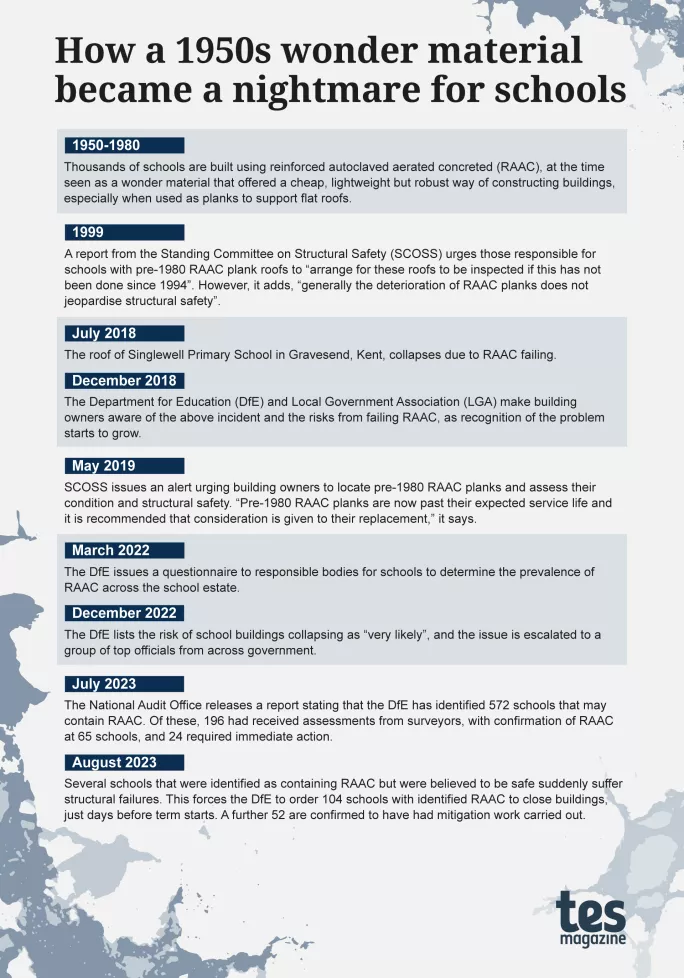RAAC: Over 8,000 more schools could be at risk

More than 8,000 schools could be at risk of collapse due to having buildings containing reinforced autoclaved aerated concrete (RAAC) it has emerged, as ministers admit more schools could be told to close.
The government said 8,600 schools it had identified as being potentially at risk were not receiving any investigations or repair work, according to a National Audit Office (NAO) report published earlier in the summer.
It comes as schools minister Nick Gibb admitted this morning that more schools could be told they need to shut areas with RAAC.
- RAAC: School collapse risks - what you need to know
- News: More than 100 schools advised to close buildings due to concrete risk
- Scotland: Government ‘must step in’ over school building safety fears
The Department for Education sent a questionnaire last year to 14,900 schools it had identified as potentially being at risk as they were built over a 60-year period between 1930 and 1990 when RAAC could have been used, according to the NAO report.
More than half (8,600) of those schools had “not responded to the survey, had not completed work, or were unaware of the risks posed by RAAC” as of May 2023, the DfE told the NAO.
Around 2,000 schools had not responded to the DfE at all, according to the NAO, which told Tes that the DfE said the remaining 6,600 had responded to say they were still carrying out an assessment or they “didn’t understand” the RAAC issue so could not say whether the material was present and a risk.
Schools urged to check for RAAC
Yesterday, the DfE said 156 schools are confirmed to have RAAC. Mitigation is in place in 52 of these schools, while 104 will have to vacate affected areas at the start of term while work is done and, in some extreme cases, close entirely.
This morning, Nick Gibb told GB News: “There may be more after that as these questionnaires continue to be surveyed and we continue to do more surveying work.”
Julie McCulloch, director of policy at the Association of School and College Leaders, urged members who have concerns about the possible presence of RAAC to fill in questionnaires and contact the DfE “immediately” if they have yet to do so.
The DfE told the NAO it had identified 572 schools where RAAC might be present by May, and had carried out assessments at 196 of those schools.
Advice had previously been that areas with RAAC assessed to be in non-critical condition could continue to be used, but Mr Gibb told the Today programme that a beam collapsed at one school over the summer that had shown “no sign” it was of critical risk, triggering the current urgent DfE interventions to advise schools to close areas.
‘To the layperson, it can look very similar to concrete’
The DfE’s process of asking schools to self-assess has today been criticised by a building expert, a trust leader and union chiefs.
Matt Byatt, president of the Institution of Structural Engineers, told the Radio 4 programme World at One: “I would suggest that to spot it and to be sure you would need to have either a chartered building surveyor or a chartered structural engineer with experience.
“To the layperson, it can look very similar to concrete,” he added.
A multi-academy trust CEO, who asked to remain anonymous, questioned how the DfE could be confident that it has all the information it needs to ensure schools are safe.
“We had photos in a [guidance] document sent in December saying: ‘This is what [RAAC] looks like - take a look around and see if you’ve got any of this stuff,’” they said. “None of our schools are affected and we’re fairly confident we’ve done it right. My question would be how confident is the DfE?
“If all the schools have done observational tests, how confident are they that they’ve all done it right? I’m aware that not everyone had done their returns either so it makes you think: a) has everyone done it right, and b) what about the ones who haven’t done it at all?”
Paul Whiteman, general secretary of the NAHT school leaders’ union, said: “The bottom line here is that we cannot expect school leaders to be experts in structural engineering. Quite rightly, they will be entirely dependent on external building experts to determine whether or not there is an issue in their school buildings.
“It is incumbent on the government to make sure that every school or appropriate responsible body has access to the necessary expertise, and the government will also need to reassure parents that it is confident that all the relevant schools have been identified and necessary measures put in place.
“Put simply, in every school where there is a risk that RAAC could be present, the necessary checks must be carried out as a matter of urgency,” he added.
Ms McCulloch said she was sure that school leaders would have sought expert advice if unsure of the presence of the material, as encouraged by the DfE guidance, but added it is “a concern that so much onus is put on schools and colleges to carry out this process”.
“This is clearly a highly specialised issue and we are not convinced that schools and colleges have been offered enough support in identifying and remediating RAAC,” she added.
School closures
It has emerged this morning that around 24 schools have been told to close entirely and seek alternative arrangements for pupils just days ahead of the start of school term.
The DfE said it will publish a list of affected schools once parents have been informed and mitigations are in place.
The government has promised to fund the costs of all mitigation works needed, but has not revealed how that funding can be accessed or how it will be allocated.
The DfE has been contacted for comment.

You need a Tes subscription to read this article
Subscribe now to read this article and get other subscriber-only content:
- Unlimited access to all Tes magazine content
- Exclusive subscriber-only stories
- Award-winning email newsletters
Already a subscriber? Log in
You need a subscription to read this article
Subscribe now to read this article and get other subscriber-only content, including:
- Unlimited access to all Tes magazine content
- Exclusive subscriber-only stories
- Award-winning email newsletters
topics in this article



